Benefits of Using Remote Management in Riva On-Premise 2.4.41 or Higher
Remote Management provides the ability to monitor and control multiple sync policies from the Riva Service Monitor. Specifically, on the Remote Services tab of the Riva Service Monitor, it is possible to
- Search for and easily view advanced options for sync policies;
- Search for users;
- Filter errors by user;
- Start the sync and stop the sync for one or more users; and
- Enable or disable sync policies more easily than in the Riva Manager application.
In an enterprise-level deployment on several nodes, Remote Management can be used to
- monitor services on multiple nodes and
- monitor and control sync policies on multiple nodes.
Introduction
The Remote Services tab of the Riva Service Monitor application offers various functions and operations. You can run them on enabled Riva services, via internal communications that the Riva Remote Service provides.
The Remote Services tab, illustrated below, is available on the Riva Service Monitor. Some configuration is required to set up the connection to existing Riva services.
.png)
Note: All the screen shots come from Riva 2.4.42.
Contents:
Initial Configuration
For the initial configuration of Remote Riva Services, see the following articles:
Functions and Operations
The Remote Riva Service allows requesting the following information from an enabled Riva service:
-
Thread Pools. Read-only information about current threads and their parameters (such as work item groups and queues, the maximum number of threads, and current threads).
.png)
-
Global Sync Configuration Service.
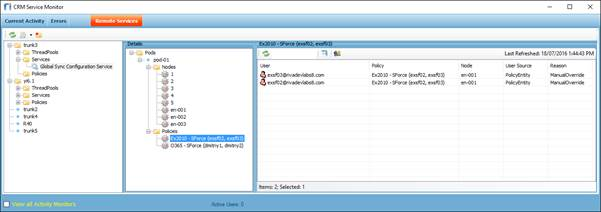
Riva 2.4.42 or higher. For an overview, see Service: Global Sync Configuration. For assistance to configure the service, contact the Riva Success Team.
-
Policies. Provides real-time access to all policies and their components of the Riva service and allows two-way communication with it.
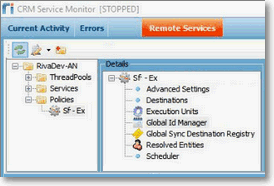
Here are the main groups of functions and operations available for policies:
-
Policies node. Shows the list of configured policies of the Riva service and allows enabling or disabling them.
-
Advanced Settings viewer. Current list of advanced settings (advanced and/or custom options) defined at the policy level.
-
Destinations viewer. Read-only list of the users statically defined for this policy.
-
Execution Units. (Riva 2.4.42 or higher.) Shows all non-sync processors configured for this policy, such as Universal Change Detection (UCD) processors and user gatherers. Allows adding or removing processors to or from the event monitors.
-
Global Calendar Management (GCM). Only in Riva 2.4.43, this tree node provides the ability to remove old entries from the global calendar management database. (In Riva 2.4.44 or higher, that ability is provided in a different manner. See Cleaning up the GCM database.)
-
Global Sync Destination Registry (GDR; also known as the Global Destination Entity Registry; Riva 2.4.42 or higher). Allows viewing current user registrations available for this policy. Also has the ability to clear selected registrations.
- Resolved Entities. Implements the following list of functions:
-
Shows dynamic list of currently resolved user entities available for sync.
-
Adds or removes user sync processors to or from the event monitors.
-
Shows sync statistics (recent or historical) for selected user entities.
-
Indicates user entities that are currently syncing or are in queue to be synced.
-
Allows starting the sync for selected user entities. Starting the sync does not mean an instant sync: instead, the user entity is added to the execution queue with a no-wait time parameter.
-
In Riva 2.4.49 or higher, can re-display the activity of a user's last sync.
-
Scheduler. Read-only viewer to show current parameters for the policy scheduler.
Policy Functions and Operations
To enable or disable a policy:
-
Expand the required Remote Service item, and select Policies.
-
Right-click the policy, and select Enable/Disable Policy.
This modifies the policy file, setting the new policy status and applying this change towards the Riva service.
View the advanced options and/or custom options
To view a sync policy's advanced and custom options:
-
Expand the required Remote Service item, and select Policies.
-
Select the policy. On the Details tree, select Advanced Settings.
All the advanced options and/or custom options that are currently specified for the policy are displayed in the informational list view.

Destinations
To view a sync policy's destinations:
-
Expand the required Remote Service item, and select Policies.
-
Select the policy. On the Details tree, select Destinations.
All destinations defined for this policy in the policy file appear in the informational list view.
Execution Units
(Riva 2.4.42 or higher.)
Execution Units are work processors that execute certain operations in their schedule. The following Execution Units are available:
- CRM Universal Change Detection (UCD) processor.
- Mail UCD processor.
- CRM User regatherer.
- Mail User regatherer.
- Global Sync Configuration (GSC) regatherer.
To view a policy's execution units:
-
Expand the required Remote Service item, and select Policies.
-
Select the policy.
-
On the Details tree, select Execution Units to view, in the informational list view, the processors that the current policy is configured to use.
Note: The parameters of execution units are read-only. You cannot start or stop their execution, but you can add them to the list of event monitors.
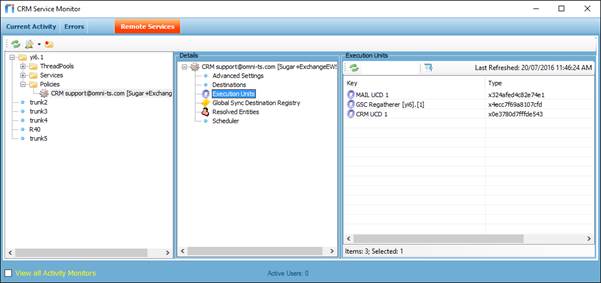
Global Calendar Management
The Global Calendar Management database contains metadata for the appointments that have been synced. The metadata consists of things like unique item database ID numbers, modification time stamps, and item change revisions to keep track of what has been synced. None of the private appointment information is cached or written anywhere.
Over time, the metadata can grow quite large, which may affect performance. Some of the metadata may be very old and can be safely deleted.
Only in Riva On-Premise 2.4.43, the Global Calendar Management node can be used to clean up the GCM. In Riva 2.4.44 or higher, there is a different way to clean up the GCM.
To clean up a policy's old metadata from the Global Calendar Management database:
-
In the Riva Service Monitor that accompanies Riva On-Premise 2.4.43, in the left pane, select Policies.
-
Select a policy.
-
In the middle pane, select Global Calendar Management.
-
In the right pane, near the top, select  .
.
-
In the Clean Up Global Calendar Management window that appears, read the information, follow the instructions, select appropriate values, and select Execute.
Global Sync Destination Registry (GDR)
(Also known as the Global Destination Entity Registry; Riva 2.4.42 or higher.)
The purpose of the GDR is to prevent syncing the same user entity in multiple Riva locations. For example, in a multi-node environment, it is extremely important to guarantee that each user is processed only once, and if another node tries to sync the same user, the attempt must be prevented to avoid any data collisions, duplications, etc. When the GDR service is enabled, it protects the uniqueness of every user entity.
To view the GDR:
-
Expand the required Remote Service item, and select Policies.
-
Select the policy.
-
On the Details tree, select Global Sync Destination Registry.
If this service is enabled for the current policy, the informational list view displays the list of all destinations registered for this policy.
In some cases, though, there is a need to move a user from one Riva location to another (for example, move user from Node 1 to Node 2). Before this operation can be completed, the GDR needs to clear the user's registration from Node 1 – to allow it to run on Node 2 (and register there during the first sync).
To clear users from the GDR:
-
In the GDR, select one or more users.
-
Right-click the informational list view, and select Clear entity reservations.
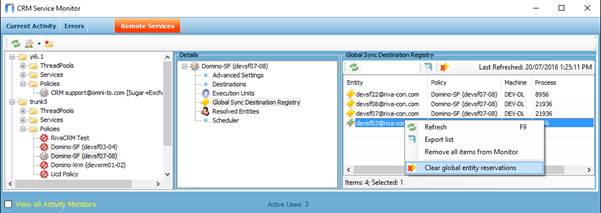
The selected users are removed from the GDR registrations.
Resolved entities
To view the resolved entities:
-
Expand the required Remote Service item, and select Policies.
-
Select the policy. On the Details tree, select Resolved Entities.
The informational list view displays the list of all the user entities that were resolved and scheduled for this policy.
Sync statistics. (See Step 2: Enable sync statistics.) If sync statistics have been enabled for the Riva environment that runs the selected policy, the informational list view displays some statistical information in two views:
- Recent View: Statistics for the most recent sync cycle. This is the default view.
- Historic View: The aggregate statistics of the last cycles, up to a maximum of ten cycles, excluding the most recent sync cycle. The aggregates are averages or sums.
Note: When a new sync cycle begins, the following occurs:
- If there are ten sync cycles in the history, the oldest is purged from the history.
- The statistics of the most recent sync cycle are removed from the Recent View and are archived in the history.
- The aggregate historical statistics are recalculated and displayed in the Historic View.
Both views display information in several columns.
- Entity State: The state of the current or latest sync for the selected resolved entity. Idle, Running, or In Queue.
- Next Sync: The time when this user is scheduled to sync next time.
- Last Sync: The time of the last sync. The statistics for that last sync have been archived and aggregated with the values visible in the Historic view.
- Duration:
- In Recent View, this is the time it took to complete the latest sync for the user.
- In Historic View, this is the average time it took to complete the historical syncs.
- Wait:
- In Recent View, this is the wait time between queuing and executing the sync for this resolved entity.
- In Historic View, this is the average time for the historical syncs.
- Errors:
- In Recent View, this is the number of errors in the current or latest sync.
- In Historic View, this is the sum of all errors in the sync history for the resolved entity.
- Creates/Updates/Deletes:
- In Recent View, this is the number of these operations encountered for the selected resolved entity in the latest sync.
- In Historic View, this is the sum of these operations in the sync history for the resolved entity.
- CPU Duration:
- In Recent View, this is the CPU time spent on that sync.
- In Historic View, this is the average CPU time spent on that sync.
To start the sync for one user entity or group of entities:
-
Select the required user entities.
-
Do one of the following:
-
On the informational list view's tool bar, select Start Sync; OR
-
Right-click the informational list view, and select Start Sync.

The selected users are added to the Riva schedule, and their syncs start as soon as possible.
Note: (Riva 2.4.44 or higher.) When you start a sync cycle for one or more entities, a transactions metadata files backup cannot take place during that cycle.
To stop the sync for one user entity or group of entities:
Note: This functionality requires Riva 2.4.42 or higher.
-
Select the required user entities.
-
Do one of the following:
-
Right-click the informational list view, and select Stop Sync; OR
-
On the informational list view's tool bar, select Stop Sync.
Communication is attempted with every sync processor that is running a sync for the selected users. If a processor is reachable, it receives the stop sync command, and the sync stops. If a processor is busy and cannot accept the stop sync signal, the signals are repeated for up to 30 seconds. After that, if the processor is still not reachable, the thread of this processor and the sync are forcibly stopped.
To replay the activity log of a resolved entity's last sync:
Note: This functionality requires Riva 2.4.49 or higher.
-
In the Riva Service Monitor, select the Remote Services tab.
-
In the leftmost pane, expand the required Remote Service item, expand Policies, and select the policy.
-
In the middle pane, on the Details tree, select Resolved Entities.
-
In the rightmost pane, in the informational list view for the selected policy, select a resolved user entity that was synced.
-
Right-click the user entity, and select Replay Last Sync.
Result: In the bottom of the Riva Service Monitor, an activity monitor re-displays the activity log of the selected user entity's latest sync.
Scheduler
To view a policy's scheduler details:
-
Expand the required Remote Service item, and select Policies.
-
Select the policy. On the Details tree, select Scheduler.
The informational list view displays all the technical details about the scheduler for this policy on this instance of Riva.
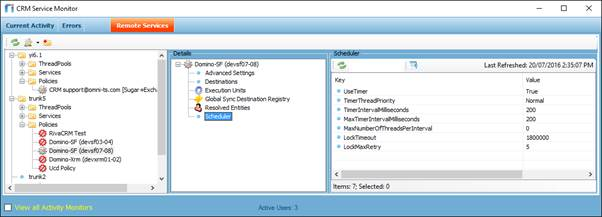
Informational List View
The informational list view provides some additional service functions:
To refresh the contents:
-
On the tool bar, select  Refresh.
Refresh.
New information is requested from the Riva remote service, and the Last Refreshed label is updated.
To filter by name:
Note: For every function available in the Detailed view, there is a corresponding name attribute that is used as a filter in the informational list view (Advanced Settings -> Key; Destinations->Name, etc.).
-
Type characters into the Filter By field.
The informational list view applies this filter instantly.
Changing the filter does not reload the contents; it just filters it.
To reload the contents, see Refresh the contents.
To navigate from one page to another:
Note: By default, the list view shows 250 items on one page. If there are more items to show, they are automatically split into pages. For example, the following screen shot shows the top portion of page 1 of a total of two pages.
-
To navigate from one page to another, select < or >.
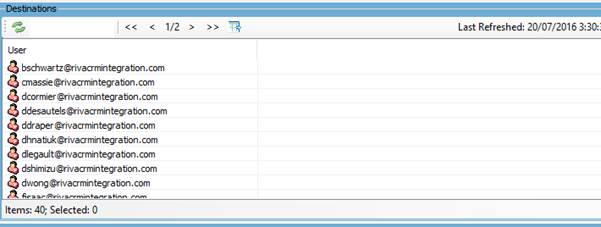
Tip: To decrease the number of items to render, filter by name.
To export the contents of the current page to a .csv file:
-
On the tool bar, select  Export.
Export.
-
In the Export to CSV File window, navigate to the folder where you want to create the .csv file.
-
Select Save.
All visible items on the page, with all the columns of the informational list view, are saved to the .csv file.
To add to (or remove from) the Event Monitor:
Note: This operation is available for Resolved Entities and Execution Units. (The latter are available in Riva 2.4.42 or higher.)
-
Select the entities or units that you want to add to the event monitor or remove from it.
-
Right-click the informational list view, and click Add/remove item to Monitor.

The list of current event monitors is updated.
.png)
.png)







 Refresh.
Refresh.
 Export.
Export.
